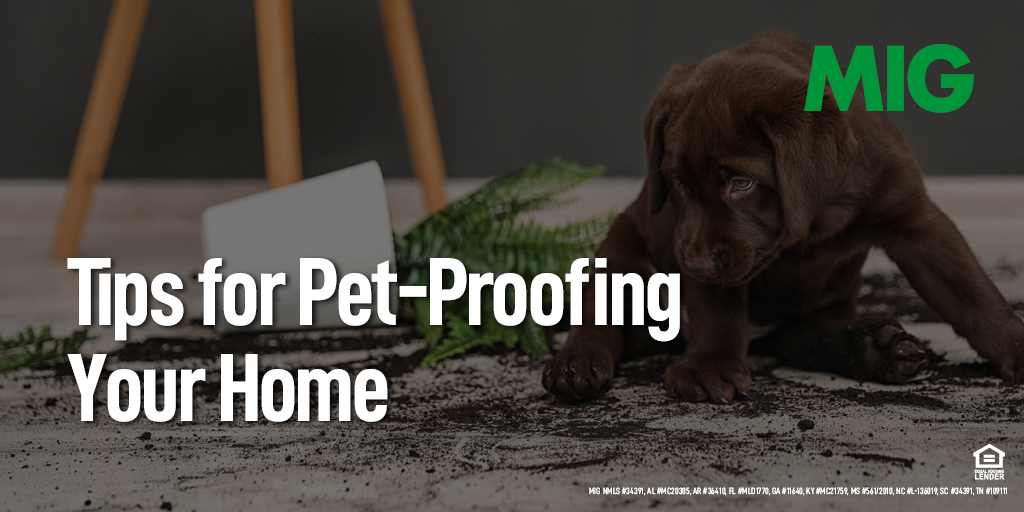Tips for Pet-Proofing Your Home

Posted by : Admin
Did you decide to extend your family to include a furry, four-legged friend? Congratulations on the new addition! Pets may take some time to adjust being in a new place. Along with a heaping helping of patience, take these steps to pet proof your home to proactively avoid messy issues.

Close Your Doors
Immediately giving an animal free rein to your entire house is a bad move. The area may overwhelm them and cause anxiety, or they may decide part of it can be used as their new potty. The first few weeks after you bring a new pet home, keep your bedroom and bathroom doors closed. This will keep them closer to you and out of harm’s way.
Prevent Choking Hazards
Dogs especially love to chew and, if left alone, this behavior can cause costly damage and be dangerous. Don’t leave them unattended with electrical cords or chew toys. If your pet shows an interest in throw pillows and shoes, keep those out of his reach, too.
Secure Your Garbage
Garbage is attractive to animals because of the smell of food wafting from it. Make sure lids on every garbage can are tightly closed and shut the bathroom doors just to be extra safe.
Keep Food Out of Reach
There are certain foods that are toxic to animal. Chocolate, grapes, and onions are just a few of them. Avoid a sick pet and possibly a vet bill by storing your food off your counters and inside cabinets and the refrigerator. If your furry friend gets into food they shouldn’t, watch them closely and contact your veterinarian.
Install a Baby Gate
It may be difficult to watch your new addition all the time to make sure they don’t get into trouble. Block your pet in a room and away from open doorways or other off-limit areas with a baby gate. They are inexpensive, easy to install, and can be removed once your pet is used to their new surroundings and trained to obey you.

Research Your Plants
Certain seemingly innocent houseplants can be toxic to your pets if they decide to chew on them. Do an online search of the plants in your home and remove any that could be harmful to your new addition. While you’re at it, move plants that will be tempting for your dog to dig in out of their reach.
Keep Your Fence in Good Shape
One of the easiest ways for dogs to get lost or hit by a car is by slipping through a hole in the fence. Keep this stressful event from happening by frequently walking around your fence to make sure it hasn’t come apart in certain areas, or that the dog hasn’t started tunneling under it. Address any issues immediately so your dog stays safe.
Watch What You Use in Your Garden
Certain fertilizers and pesticides can be dangerous to pets. Read the ingredients closely and ditch anything that may harm your new four-legged friend, such as cocoa bean mulch. Think about using only natural ingredients in your garden so you don’t have to worry about this issue.
Make Them Comfortable in a Kennel
Leaving your animal unsupervised in your home can lead to all kinds of trouble, including expensive damage to your furniture and floors. Train your new pet to stay in a kennel. Kennels help animals feel safe and secure while you’re gone, and keep them safe from getting into situations that could hurt them.
Train Them
Integrating a pet into your household means teaching them how to behave and how to recognize boundaries. House training is essential, as is teaching them commands like sit, down, stay, and off. Not only will training create a more pleasant pet-owning experience, it also keeps them safe from dangerous situations like running out the door and into the street.
Deciding to get a new pet is exciting and can be rewarding. Set the ground rules early, and examine your house, both inside and outside, to ensure it’s safe and free from tempting dangers. You’ll enjoy the relationship you forge with your new furry friend for years to come!



